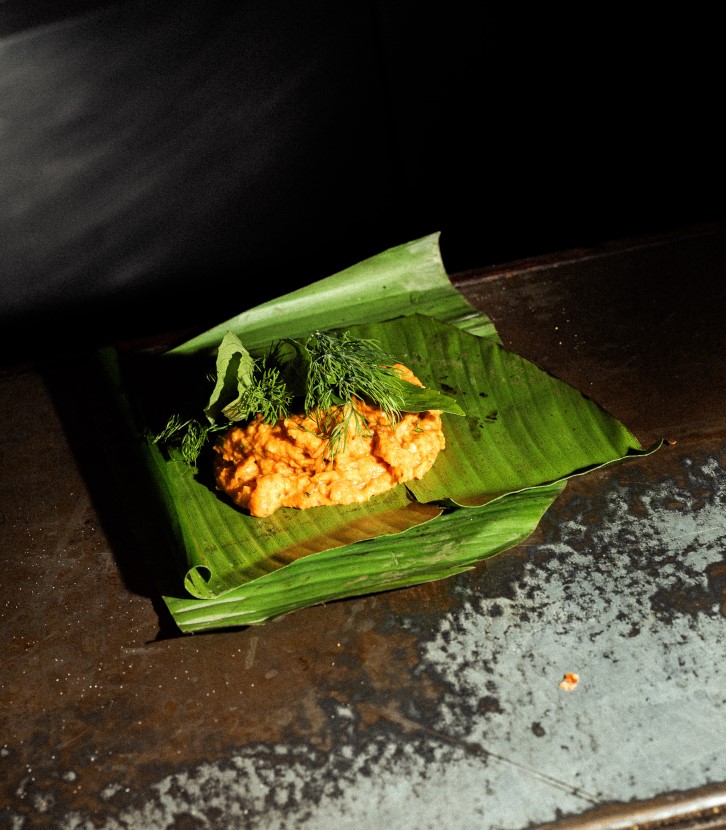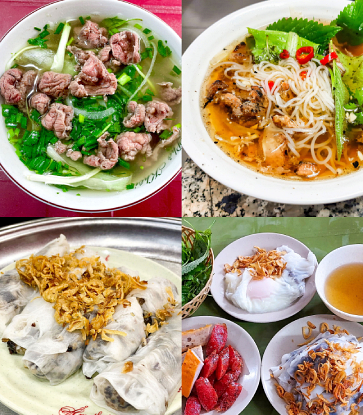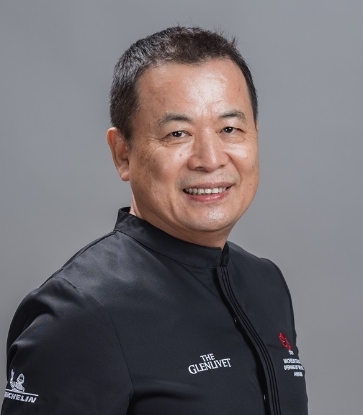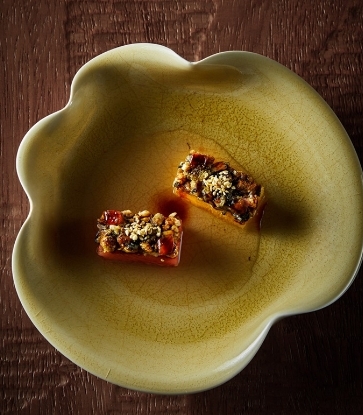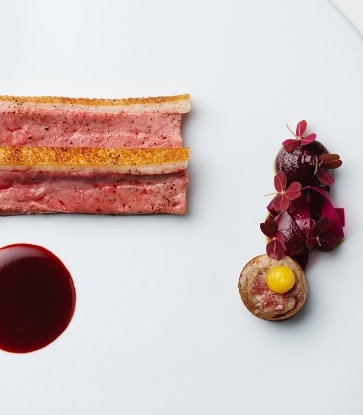The bread course is often one of the first treats presented to guests at a fine dining restaurant, before the feast to follow. These days, it is no longer an afterthought; rather, a memorable opening to make an impactful first impression and lay the foundation for the meal to come.
Here are five restaurants in the MICHELIN Guide Taiwan that serve meticulously crafted bread courses. Tuck into these baked beauties and experience the core and philosophy of each restaurant in every bite.

Natural Yeast Sourdough Bread
holtOne MICHELIN Star, MICHELIN Guide Taiwan 2023
For chef Jeffrey Downs, bread in Western fine dining holds the same indispensable position as rice in Japanese cuisine. “Bread makes the perfect ‘hello’. Fresh, warm bread has the power to make people feel alive,” he says.
He first learned the art of baking bread while attending culinary school in Canada, and the restaurants he later worked in across Europe all served excellent homemade bread. "In this way, if you eat good bread every day and get to know the people who make these perfect breads, you will begin to recognize and shape in your mind what good bread should look like." Downs believes that any mature and skillful chef worth his salt should be able to handle the basics of every kitchen station, including the bakery.
(Photo: Chelsea Su)

Later, he traveled to various Asian countries for work. "But no matter where I was, whether in my hometown or whichever country I went to, if I was at a fine dining restaurant or a bistro, I always liked ordering sourdough bread. It pained me whenever I tasted a wonderful sauce, but didn’t have a piece of bread in hand to mop it up. So when it came to opening a restaurant of my own, I wanted to make sourdough bread and present it to my guests in the style I like."
Downs said that his first year in Taiwan was the most difficult one because he had not yet adapted to Taiwan’s changeable and often humid climate. So serious is he about his craft that he even takes the jars of yeast home to raise and take care of.
(Photo: Longlong Han)
On his days off, he also enjoys going back to the restaurant to knead dough and bake bread. These days, running the restaurant takes up more and more of his time; and yet, even though he has kitchen staff to bake the bread, he occasionally reminisces about his time spent baking. "It's quite therapeutic to do something where you don't have to watch the clock all the time," he says, with a smile and a sigh.

Whey Ciabatta
INITAOne MICHELIN Star, MICHELIN Guide Taiwan 2023
For chef Kunihiro Hagimoto, Italian cuisine has a very strong connection with the local terroir. This philosophy is not only reflected in the restaurant’s name — a portmanteau of Italy, Nippon (Japan), and Taiwan, but it is also evident in the restaurant’s signature Italian bread course — the ciabatta.
A longtime fan of using Taiwanese producer Man Mano’s Italian-style cheeses made from local milk, Hagimoto had a moment of inspiration when developing his bread course. He had always liked using whey, a by-product of cheesemaking, in dishes like risotto and pizza, for the complex flavor it brought to these classics. Because of this, he decided to add whey into the bread dough.
(Photo: Chelsea Su)
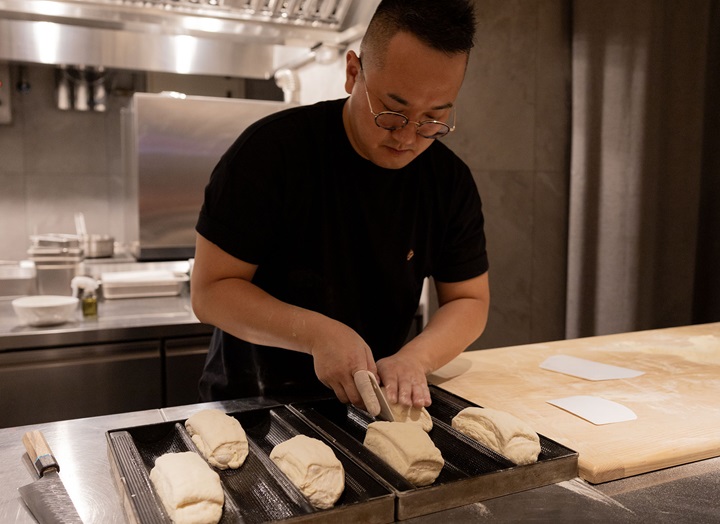
INITA's bread is made from three types of flour from Italy, mixed in perfect proportions by the chef's private kitchen, to which whey is then added in place of water. And because whey contains protein and calcium, it gives the bread higher nutritional value. After baking, the bread feels fluffy at first, but becomes heftier upon chewing. It is paired with a nutty, aromatic Burro Nocciolato cream for an unforgettable flavor combination.
"I have never thought about serving bread made by anyone but ourselves. For me, delicious homemade bread is the way to build a sincere relationship with our guests," he says. Jovial and often smiling, the chef turns serious when talking about the importance and meaning of bread to him.
He explains that bread may seem like the simplest course, but it is not easy to achieve consistent quality because of the laborious process required to make it. It is a very hands-on process that requires fine-tuning and adjustments based on the weather, timing, and temperature. “Bread is the easiest way to tell how meticulous a restaurant is,” he says.

Pan de Campo Country Loaf
ZEAOne MICHELIN Star, MICHELIN Guide Taiwan 2023
Chef Joaquin Elizondo believes that bread bridges cuisines in fine dining experiences, because no matter what cultural background you come from, you can connect with bread at a visceral level. "Good bread doesn't lie. You'll know it as soon as you eat it," he says, emphasizing that good bread lies in the mastering of three elements: taste, temperature and moistness.
At ZEA, Elizondo uses a mix of whole wheat, rye, and white flour kneaded with Taiwanese sea salt, specially filtered water, sourdough starter, and fresh yeast. When you bite into the bread, the thin crisp crust gives way to a moist and tender crumb, a surprising and delightful juxtaposition of textures.
(Photo: Chelsea Su)

Because of other creamy and rich dishes to follow in the dégustation menu, the bread is not served as it usually is with butter, but with Zuccardi olive oil from Argentina, where the chef is also from. The restaurant serves four different styles of single-origin olive oil, allowing guests to experience four different flavors and tones at one time.
The chef imbues his personal touch to the bread. "Due to climate, temperature, and other variables, it is not easy to maintain the quality and consistency of the bread. But because it is a very important component in the dining experience, I need to personally check it.” At the same time, baking the bread by hand himself also gives the chef a temporary respite from the hectic mood of running a restaurant — a moment of rest and happiness to just fully immerse himself in doing one thing. So, the next time you visit ZEA, don’t forget to give him the time of an extra loaf of bread!

Taiwan Oil Millet Sourdough Bread
LA Vie by thomas bühnerMICHELIN Selected, MICHELIN Guide Taiwan 2023
In expressing chef Thomas Bühner’s culinary philosophy, executive chef Xavier Yeung has put great effort into the bread selection in the restaurant. “For Chef Thomas and I, the bread course is not just meant to fill the guests up, but to introduce the concept of connection by breaking bread,” he says.
The crust of the sourdough bread — embossed with the words "LA VIE" — breaks open to precisely cut segments. Yeung explains that in European custom, the bread is often placed at the center of the table, allowing guests to break off the size of the piece they want to eat.
(Photo: Chelsea Su)

But soon, the chefs realized that Taiwanese people did not have such a habit. And so, they made adjustments.
The key ingredient that sets this sourdough bread apart is a superfood that has gained attention in Taiwan in recent years: Taiwan Oil Millet, an endemic species with high nutritional properties. The chef’s eyes shined as he spoke enthusiastically of the ingredient.
He explains how, in the past, the millet was often boiled and eaten plain — an unpleasant dish with little to no flavor. However, when it is tempered in a pot to a certain temperature, the aroma of roasted grains is released, imparting a surprising whiff of popped corn when baked with whole wheat and rye in a bread.

Flavored Brioche
MajestyMICHELIN Selected, MICHELIN Guide Taiwan 2023
Since its opening, Kaohsiung’s Majesty has become quite known for its photogenic and delicious homemade brioche. Current chef Fabien Vergél inherited this tradition when he joined the team, won over by the warm, soft bread as a fitting appetizer for the meal ahead.
He says: "In Western cuisine, the concept of sharing is valued, and the first medium for sharing is bread." Well-made bread is a show of sincerity to guests. At the same time, the quality of the experience a diner receives really starts with bread, which seems simple but is actually the most complicated.

In the past, the brioche was mainly flavored with kombu butter; but now, the chef has introduced other spices and seasonings to the bread, according to the season and menu.
For example, Vergél will adjust or add other spices to the brioche, according to the season and menu. A recent version of the brioche was flavored with sweet and mild Espelette peppers from the chef’s hometown, combined with dried red bell peppers. Served with a spread of fermented tomato cream, the appetite-whetting combination was given a fitting nickname of “dry sorbet” by the chef.
Hero image: INITA's Whey Ciabatta, courtesy of Chelsea Su
Original article in Chinese, written by Chelsea Su; translated into English by Rachel Tan



